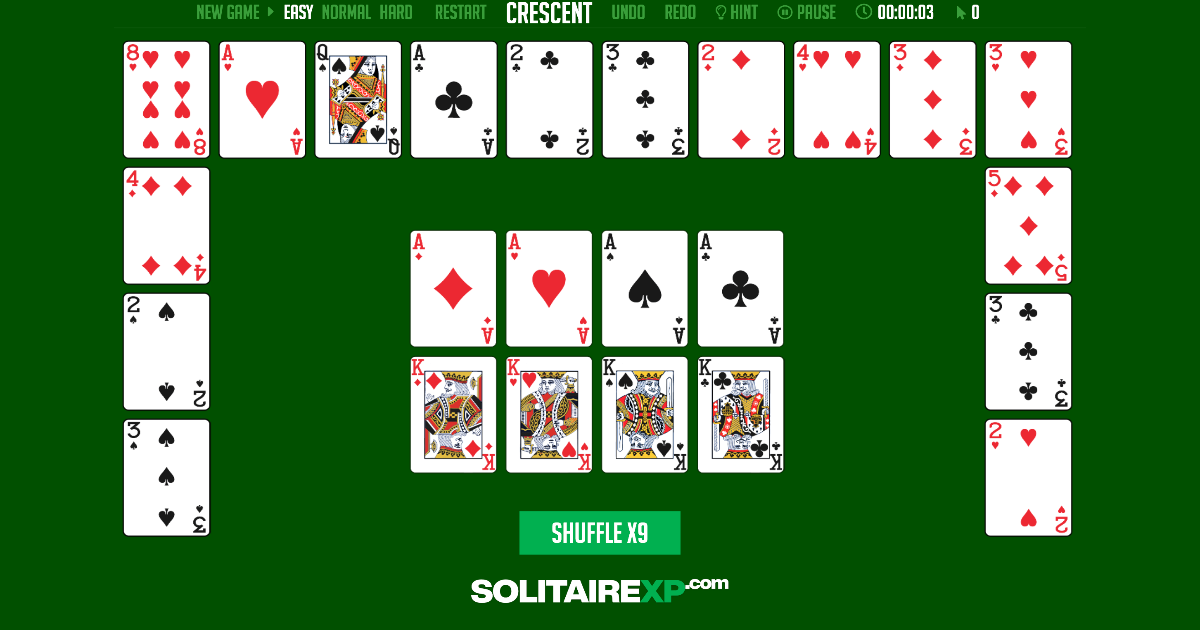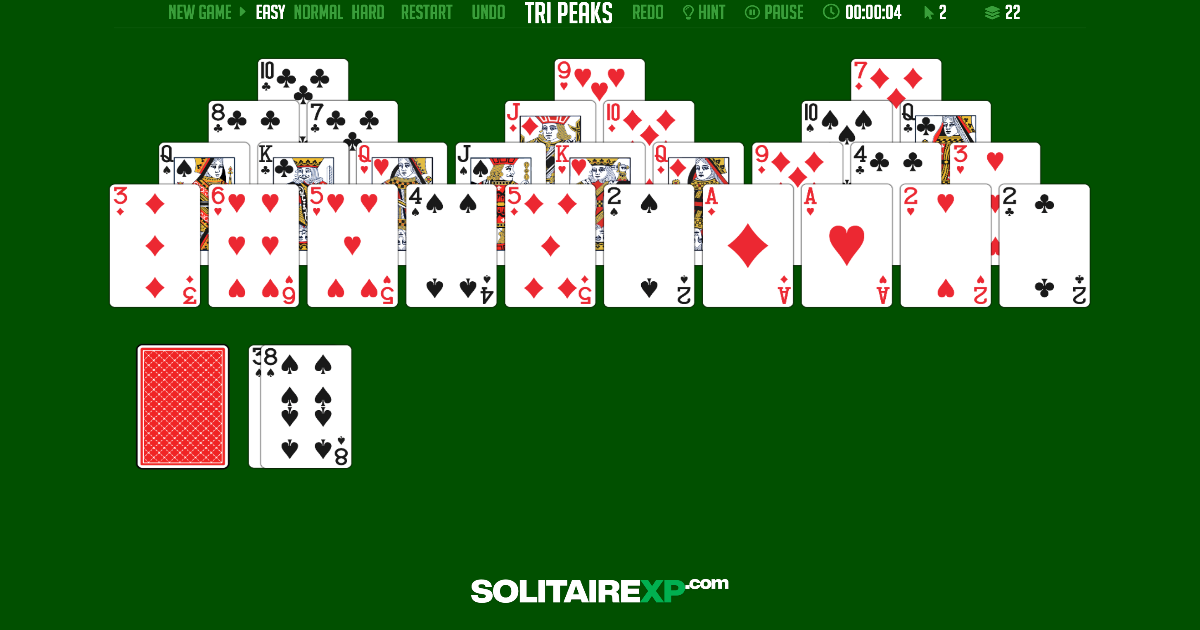Crescent Solitaire is a challenging two-deck solitaire variant with a distinctive crescent-shaped tableau. It rewards planning, suit management and careful use of limited reshuffles.
What is Crescent Solitaire?
Crescent Solitaire is a captivating and challenging variation of classic solitaire played with two full decks of cards. Its distinctive layout features 16 foundation piles arranged in a semi-circle (or “crescent”) shape — eight building up from Ace to King and eight building down from King to Ace — along with a tableau of 104 cards dealt into 16 piles.
What sets Crescent Solitaire apart is its unique blend of strategy, patience, and a touch of luck, offering a refreshing twist on traditional solitaire games. The elegant crescent arrangement and the dual-direction foundation building create an engaging puzzle that keeps players coming back for more, making it a favorite among solitaire enthusiasts looking for something more intricate than Klondike or Spider.
The game is believed to have been popularized in the 1990s through various digital collections, including early versions of Microsoft Windows entertainment packs and dedicated solitaire software. For more details, see the Wikipedia entry on Crescent Solitaire.
How to Play Crescent Solitaire
🌟 Objective
Your goal is simple: build all foundation piles from Ace to King, and from King down to Ace (depending on the variant). If every card reaches the foundations before you run out of moves, you win! 🎉
🃏 Game Setup
- Uses two full decks — a total of 104 cards.
- Eight foundation piles are placed in the center.
- The remaining cards form a large crescent-shaped tableau around the foundations.
- You get a limited number of reshuffles (9 reshuffles) to help you when you’re stuck.
🌙 How the Crescent Layout Works
The tableau forms a curved arc—just like a crescent moon. 🌘
You can move cards between tableau piles or onto the foundations, but every move must follow strict suit and rank rules.
➡️ Gameplay Steps
- Move cards from the tableau to the foundations whenever they match the next rank in ascending or descending order.
- Shift cards between tableau piles if they are one rank apart and in the same suit (rules may vary depending on the version).
- Stuck with no moves? Use one of your reshuffles to refresh the tableau. 🔄
- Repeat moves and reshuffles until either all cards reach the foundations… or no legal moves remain.
🏆 Winning Conditions
You win when all 104 cards from both decks are successfully moved to the foundation piles.
It’s a challenging puzzle, but incredibly satisfying once completed! ✨
Crescent Solitaire Rules
- Uses two standard 52-card decks (104 cards).
- Cards must be moved following suit order rules (variant dependent: ascending or descending foundations).
- Tableau moves usually allow only one-rank shifts within the same suit.
- Reshuffles are limited (typical default: 9).
- No free cells or wildcards in standard rules.
- The game ends when no legal moves and no reshuffles remain.
Tips and Strategies to Win Crescent Solitaire
- Prioritize foundation moves: move to foundations whenever it does not block future essential moves.
- Delay reshuffles: use reshuffles late—save them for when progress stalls.
- Avoid locking cards: don’t bury high-value or critical suit cards under many others.
- Balance uncovering: expose cards from multiple tableau piles instead of clearing one pile at a time.
- Plan sequences: look for multi-move sequences that free more cards than a single move.
- Track suits: focus on suits that already have good foundation progress.
Common Mistakes to Avoid
- Using reshuffles too early in the game.
- Over-stacking a single tableau pile and ignoring others.
- Moving cards without considering suit balance and long-term sequences.
Variations of Crescent Solitaire
Common variations include:
- Crescent Easy Mode: For beginners with simpler layout.
- Crescent Normal Mode: Difficulty level increased, requires both skill and luck.
- Crescent Hard Mode: Difficult version, requires careful planning.
Similar solitaire games:
Crescent Solitaire vs Other Solitaire Games
| Feature | Crescent | Klondike | Spider | TriPeaks |
|---|---|---|---|---|
| Difficulty | High | Medium | High | Low |
| Decks | 2 | 1 | 2 | 1 |
| Reshuffles | Limited | Unlimited (draw mechanics) | None | None |
| Strategy Level | Very High | Medium | High | Low |
Why is Crescent Solitaire Popular?
Players enjoy Crescent Solitaire because it rewards careful planning and suit management. Its unique layout and limited reshuffle mechanic create a satisfying puzzle-like challenge that appeals to serious solitaire fans.
Play Crescent Solitaire Online
Play the game online for instant shuffling, auto-move options, undo features and free practice.
FAQs about Crescent Solitaire
Q: Is Crescent Solitaire hard to win?
A: Yes, it’s considered high difficulty because of limited reshuffles and strict suit rules.
Q: How many decks does Crescent Solitaire use?
A: Two full decks (104 cards).
Q: Can I move cards between tableau piles?
A: Yes, typically only within the same suit and one rank apart (variant-dependent).
Q: What happens when I run out of moves?
A: If you have reshuffles left, you may reshuffle the tableau. Otherwise the game ends.
Q: Is there a time limit?
A: Most online versions have no time limit; they focus on strategy rather than speed.




Comments (0)